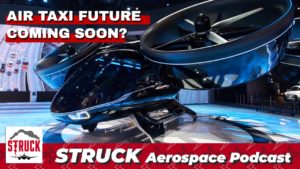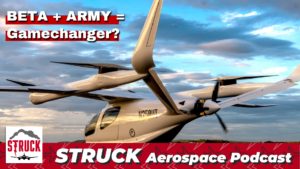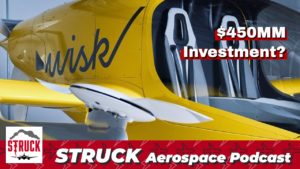Will Jetoptera’s fluidic propulsion system work, and reach new applications of aircraft? SpaceX wants their satellite wifi on planes–can they make the technology work with existing radomes? And, can a 3-winged jumbo jet really deliver on fuel efficiency and lift projections?
Learn more about Weather Guard StrikeTape segmented lightning diverters and aircraft lightning protection consulting services. Follow the show on YouTube, Twitter, Linkedin and visit us on the web. Have a question we can answer on the show? Email us!
Podcast: Play in new window | Download
Transcript: EP59 – Jetoptera, 3-Wing Jumbo Jets, SpaceX WiFi & More
0:27
Alright, welcome back to the struck aerospace engineering podcast. I’m your co host, Dan Blewett. On today’s show, we’ve got a lot of prototypes to talk through. So my co host, Allen Hall here is gonna kind of pick apart a bunch of these different designs, talk about some of the good things and the bad things. And but we’ll start with some news, Airbus, talking about hydrogen starlink, internet, potentially providing fast Wi Fi to planes or something pretty interesting that I hadn’t thought about. And then we’ll get into some different concepts of trialing jumbo jet, and electric sea plane. And a really interesting what’s called a fluidic propulsion system on a flying car concept, as well as one that has the wings, detach and fly home. So again, this would be kind of fun. But let’s start with news. Allen. So Airbus has said that the, you know, hydrogen is probably not going to be widely used in planes before 2050. So 30 years off, Does that sound right to you? Well, they’re talking about larger aircraft, like in a 328 350 kind of aircraft not being able to switch over to hydrogen, I think that’s right. The shorter kilometer type aircraft, maybe propeller driven aircraft will be an easier conversion. And it makes a lot of sense, because there’s a lot of short routes in Europe and also in the United States, that could handle a hydrogen aircraft, but it’s gonna have to be specifically designed. And that’s why Airbus is pushing the back a little bit. I think, early on, there was an impression like we’re going to make an Airbus A 350. with hydrogen. That’s not where Airbus it. I don’t think that’s where their intent was. I think eventually, yes. I mean, that’s that they did put up some PR about that, right. I mean, we saw the promotional things.
2:10
But that that didn’t have a timeline, if they’re talking about hydrogen aircraft. Yeah, I think they can totally
2:18
like an ATR 72, or the dash eight q 400 turboprop aircraft, aircraft would be relatively modifiable into a hydrogen configuration. But after that, when you talk about changing a turbo fan engine to hydrogen, and all the infrastructure involved in aircraft to for the fuel system, that’s just going to take a long time, because there’s so many, so many pieces to it. Hydrogen is a very small molecule, it leaks everywhere.
2:49
Whereas liquid fuel doesn’t do the same thing. So all that is all the design elements change, and pressures, and temperatures are all different. Just starting over. It’s what’s what’s what Airbus is saying is like, Look, guys want to start over?
3:05
We can’t do that overnight. We can’t even do it in 10 years. Yeah, so it’s definitely they’re gonna more all these current planes that use turbo fans to just run their course, essentially. And then, like I said, just start from scratch, like a different designer. I mean, do you see it being like a really wacky, very different looking like futuristic looking? Or is it just gonna be an A 320? That’s still pretty normal looking that runs on Hydra? Like, is there a reason that it has to be strange looking to be futuristic and use a different system? Because like, all these renderings You see, like, yeah, so Oh, they always seem very science. fictiony. Right, but right, because it has to be that way, or it might look the same. And 2050, I think the aircraft, essentially, it’s gonna look the same, except that the fuselage may get longer because the initial concepts involve putting hydrogen storage tanks of some sort. In the fuselage, the storage is a big one, right, so that the few stores may get longer, which means the wingspan may get a little bit longer also, to keep every aircraft sort of unbalanced. But that’s it because the wings will have no fuel in them liquid fuel on them. So you’ll completely redesign the way the wings would be, because there’s need to maintain their own structure don’t have any fuel sloshing around them. So the structural change there too. Yeah, it’s gonna it’s gonna be a basic fundamental kind of Airbus 350 kind of look, I think, but just what the longer fuselage section and tail so moving on starlink, which is obviously Ilan Musk’s company with SpaceX is talking about putting starlink internet into airplanes in the upcoming future, with potentially 100 megabyte per second download, and 20 megabyte per second upload, which would be much faster than I mean, Alan, you’re a much more frequent more inflight internet user than I am. What do you guess that it is?
4:57
It’s not great. It’s it’s not as bad
5:00
It used to be it’s certainly gotten better, right? But yeah, what do you think they’re competing with, as far as upload download speed today, the consensus is they’re competing with what is in people’s homes. So that’s what that’s the expectation levels. When you get an aircraft, you have the same speed internet as what you have at the house or at work. And it hasn’t been that way. I fly Southwest a lot. And global eagle is the service provider there. And the internet speeds aren’t super fast, like you can’t stream anything, you can’t have huge downloads, you can’t stream a YouTube video or watch Netflix live. But you can do pretty much everything else. You can send email, you can download some files, it’s it’s not. It’s not like being at work, or it’s not like being at at your house. This is not they’re not there. But for most situations, it’s reasonably good. It’s not even really annoying. Honestly, I I’ve never tried to do massive internet file sharing while on an airplane. But maybe somebody has. And I know if the if YouTube were offered, or live video streams were offered, people would take it and would use it was just not there yet. But you know, Dan, the the issue with the with, like starlink. And there’s a couple others that are going on simultaneously is that you have this geometry problem. Right now, the way the way the situation is the spacecraft are geosynchronous that means they’re in a fixed position.
6:34
With the earth, they’re always in the if you always look in the same spot in the sky, it’s always there. So from the aircraft perspective, when it’s flying, it kind of knows where it is, for the most part. And it knows generally where to look. And solar, it just takes one antenna to focus on one spacecraft, and just sort of lock in on that hold it. That’s relatively simple to do
6:56
when you put a lot of low Earth orbit, spacecraft in there moving and spinning around the Earth, so if I look up in the sky, I can actually watch the spacecraft go over ahead of me. Okay, so now I got a moving aircraft and I got a moving spacecraft. And I got to connect data link those two together. Alright, that’s doable. So you have an antenna that knows generally what the schedule is of spacecraft, I would assume. Or it’s out there just searching for one, and it finds one that links into it. Okay, great. So you’re, you’re downloading your YouTube video with this one spacecraft as it’s moving relative to the airplane. Awesome. Well, at some point that that that spacecraft is going to go out of range gonna go over the horizon, you’ll lose it. So you got to get to the next spacecraft and connect with it. So in the interim,
7:49
yet one of two choices, you stop with the first spacecraft, let it go, and look around and find the second spacecraft, which means your YouTube video will stop streaming in that time period, train a spacecraft one spacecraft to that kind of sucks, right? People don’t like Internet that’s kind of spotty, which it would be spotty like that. The other way to do it is have spacecraft one kind of get near its edge of coverage and the antenna be able to see spacecraft to and will link into it and connect with it before you lose spacecraft. One. That’s the engineering issue. How do you connect to the Orion you connect with spacecraft to before you disconnect?
8:32
That’s the issue. Right? So in terms of, of existing hardware, today on that the antennas that sit on the airplanes,
8:41
that hardware is not able to make what they call make before break, it can’t make before break. If yet, you have to add either more antennas. So you have two antennas looking in two different directions, which is doable, or you have to have an electronic antenna that can look at two different spacecraft or more simultaneously. There’s your dilemma right from the engineering side, it gets a lot more complicated to keep track of all this moving stuff in the sky. And walk into it when you’re just moving aircrafts going up, down, left, right all over the place and bounce into turbulence and try to keep all this organized. There’s a technical challenge. So can starlink provide better data streams? Yes. Does it require more complex hardware on the aircraft? Oh, yeah. And the big the big drawback has been so far on the electronically steered antennas, is that it takes a lot of power. To do this to do the electronic steering, and all the processing stuff that has to happen. The antennas get hot, like really hot, and particularly if you’re on the ground, it’s not so bad. If you’re flying where it’s like minus 70 degrees Fahrenheit out there and it’s in the sky. That’s awesome. It’s a big heatsink, it’s sucking all the heat out. But if I’m in Dubai, I’m on the ground and it’s 120 and I want to stream
10:00
a YouTube video, that antenna is going to get really hot, it’s gonna get hot enough on a composite airplane like a 350, where it may damage aircraft skin, the fuselage. And you’re not going to do that, right, because you may trash an airplane doing that really damage it sufficiently. So there’s a technology problem, which is, we want to have higher data streams. And we want to do this low Earth orbit thing on spacecraft.
10:29
But we got to deal with all the heat. So either we have a heat issue, and nicely smooth antennas or you have two antennas look in different directions. That’s, that’s the choice. And right now, no one’s made that choice yet.
10:43
SpaceX is
10:45
has some I think there wasn’t Gulfstream airplanes out there with prototype antennas on the flying around to try to see how the system works. But ultimately, you got to certify it. And the heat issue is going to be a big problem. That’s such an interesting answer. I mean, I wouldn’t expect anything less from you, since you’ve worked with so many these companies like viasat, and gogo, you know, on radios and you know, your ins and outs here. But people think, Oh, yeah, let’s just upgrade the internet. And they never think that it’s so technical on that. There might be other issues of damaging the actual airplane like that. Just, it’s crazy how many of these aircraft issues are just way more complex than they seem right. And you’ve had a lot of they’ve had a couple of companies starting to stop on electronically steered antennas, there’s no moving parts there. And that that has not come to fruition, they’ve always had this heat problem, they can couldn’t get over Finn calm, which is the antennas for gogo, which looked like sort of pizza plates,
11:43
that spin so that they are flat when they’re around. And they steer sort of but they also spin which is part of the steering thing.
11:53
there they’ve been talking about being able to make before break and maybe having two sets of antennas, but they’re really low profile. And their and their efficiency is really good. And so that they find thing constantly found a sweet spot there. I’m not sure it’s the ultimate final answer. But it’s a pretty good answer for right now. And I I think you may see, like two sets of antennas, installed thin comm antennas that would do the make before break and do all the Leo stuff that may be the the least the interim solution, maybe the final solution if it works well.
12:32
Alright, so in our engineering segment, Today, we’re gonna talk about this really fascinating prototype from SC aeronautics. That is a jumbo jet, the SC 200. So super efficient subsonic jet, they say can carry 264 plus passengers at Mach 0.9, with a range of 10,560 miles. And one of the key features here is that it has three wings. And that is going to give them some sort of aerodynamic boost. Allen, you know, there’s been a bunch of really interesting concepts that we’ll talk through here, many of which have come from Robert port Comm. So definitely check out their website. They seem to really enjoy all these, you know, futuristic prototypes, prototypes of planes, cars, buses, no boats, all of it. But what’s the advantage of having multiple wings? And why don’t we see planes with multiple wings? Because it doesn’t work very well. dynamically? Why are they touting it? Well, are they say, between sort of standardized flight, and then what actually happens in flight and all the weird configurations in aircraft can get into, and all the limitations and flight demonstrations that are put on an aircraft to show that it’s safe to fly, that it stalls safely, that the pilot can control it into stall and out of stall?
13:52
And all the other odd flight performance things that have to happen there. That’s where you get back to these conventional designs because they have shown effective
14:05
means of complying with the regulations bmfa or yassa, or Transport Canada, it doesn’t really make any difference, right? So you’re from from an aerodynamic standpoint, it may work. Doesn’t seem like it’s going to work, but it may work but there’s so many variables in certifying an aircraft that unique designs kind of get tossed to the wayside because can be so expensive to show that they work. It can imagine building a full scale prototype a full scale aircraft, and then going out to flight test it and go, Oh, man, we got a problem. We can’t get over. Yeah, because if if one, one wing or something, like can’t just chug away when I saw the good old days, I used to do that actually, when I worked at beach aircraft back in the 90s, I guess. There’s a really interesting discussions about how they made airplanes and how they modeled airplanes at night. So they fly during the daytime, and then they’d model at night and they would live
15:00
Cut off parts of like tails and stick on another tail. Because a lot of times are made out of wood. So yeah, I mean that that day and time as has gone by where he could cut off and lop off and reattach different parts of the aircraft. That doesn’t happen very much anymore, particularly with composites. And aluminum. This doesn’t really happen all that much. Yeah. So you hate to be a half a billion dollars into it and realize you can’t certify it. That’s the wrong time to find that out. Well, and you’ve said that many, many times can’t certify it realize, you know, find out you can’t certify it. I mean, what does that mean is it just means that you’re getting a room and you realize that there’s just a hurdle that I mean, what does that actually look like? When they say we can’t, it doesn’t happen very often today. But if you have an aircraft, you have a set of regulations or performance regulations, a minimum performance, I always call them minimum performance standards, the FAA and he also create minimum performance standards, the aircraft can work better than that. But at a minimum, it’s going to do these things. And so what happens is,
16:07
if you have like stall can be a big one or zero, GE pushovers or some of those
16:13
swept wing aircraft can have a problem in certain flight configurations where they want to deep stall and roll over. There are certain aerodynamic features about an airplane that if not dealt with correctly, you can’t certify it.
16:30
So that’s why you see, if you look at a new clean sheet, aircraft design, and maybe that first flying prototype aircraft, and look at the wing, look how clean it is, and then look at what’s certified at the end. Usually, those little bit of aerodynamic treatments, vortex generators, stall fences,
16:47
trip boundary trip layer, things in the leading edge, where, where were they, where they couldn’t certify it without adding on pieces. And that’s what it means is that you couldn’t certify it. So they needed to add some adjustments until they aerodynamics, you see that a lot. From first prototype to the final design, if you choose a very unique design, which no has no proven data, you really didn’t know where to go. So if you got into a performance issue or a safety issue in terms of its flight performance, you’re in this weird aerodynamic space where you don’t have any history, and you don’t know what the little band aid just does our to fix it. Right. And so you’re into this big r&d effort. Late in a program. Now, a lot of aircraft, there’s been a number of aircraft have had issues structurally,
17:37
that sunk them in terms of
17:41
pressurization cycles, or sort of ultimate loads that they don’t handle. That can be very, very expensive to fix late in the program, we’ve been around a couple of those. And it when you have an aircraft structure fail at a low that’s less than what’s required. That’s a big deal. Because at that point, you probably have 10 aircraft on the line you’ve already manufactured. And you got to go back and fix the structure. That’s expensive, and it’s time delay. And that can pretty much sink a program if you’re if you don’t have the cash to withstand it. So it just sounds like it just is going to continue just to be little iterations on the designs you already have. And for something this big, I mean, it’s a jumbo jet. So like you said, the idea of this thing, being actually produced without having that real world data. Whether it’s not it’s going to be certifiable is, is pretty scary. It’s It’s scary, right? And that’s what drives investors away. But we’re seeing a lot of investment into Evie tall, they have very unique designs today. But again,
18:49
there’s a big downside risk and you can’t certify it. And you could be literally a billion or 2 billion into an aircraft program, realize we got to make big adjustments to it. And
18:59
Kwazii start over or at least go back to early stages and that it eats up so much cash that he just can’t, can’t make it through it. Alright, so moving on to our E VTOL. And really just electric segment today. There’s a bunch of other prototypes that are just interesting. Maybe the future maybe difficult to come to fruition. First on the docket. This also one we found on Robert port, an all electric seaplane, the Regency glider, and it’s gonna fly 180 miles per hour just above the water surface. I mean, it’s got looks like just like turbo props.
19:39
But Alan, I mean, is there a huge market for sea planes and how how common is this the planes are hovering close to the water. Well, the Russians have done this or Soviets have done this for a long time going across some large bodies of water. Basically, you’re sort of like this ground effects situation where there’s a cushion of air real close to the surface. So
20:00
You get the aircraft movingly a little bit, you can kind of get it where that you got some your basic compressing the air down into the water, and it creates this little cushion of air, it’s very similar to when you’re landing like in a 737 you get close to ground, you feel your crowd kind of float. That’s what they’re working on and work on that float process.
20:21
I have felt that Okay, interesting, right. So it’s an aircraft that lives in that principle. So it’s only a few feet off the surface. But you can move fairly fast and it doesn’t, you’re not that far off the off the ground where there’s a huge risk me if you lost thrust, the airplane would just settle into the water again,
20:40
be a gentle landing, just like you do anyway. So from a complexity standpoint, it’s not very complex, but you’re really limited where you going to fly this thing which is overwater. Right? So if you’re going across
20:52
from Long Island to Connecticut, or something you could do you could do that. And if you’re going from I don’t know, Gulf of Mexico or from Texas to Florida or something, you could do that it’d be a slower mode of transportation, but are shorter routes I could be going across Lake Michigan, it’d be totally possible. Just think of it like a quasi very fast boat. I mean, it’s essentially yet it’s just riding on a cushion of air all the way across. So it’s it’s a neat concept. We haven’t seen it used in the United States and forever I know I think it was back in the 40s when the last time I remember
21:28
there was some work like that but there are active aircraft which would be today’s Russia I believe that is still working on that principle that are kind of cargo aircraft that move things from place to place on that cushion of air. It’s really interesting technology but haven’t seen it much using United States in a long time. Well and one other feature of this sea glider is that it also can go through the water on foils very similar so it has these things that come down and yep so it acts as a you know, it’s like a like a water taxi a ferry so the company region’s got for under 65 million in provisional orders. So it sounds like there’s definitely some interest here which that was pretty cool. What wait a minute 465 million Is that what you just said
22:14
wow, okay, that’s a lot of cash mercial airline and
22:20
for that’s a half a billion dollars for my math at the fair market is alive and kicking.
22:28
So Wow, yeah, I’ve never want to see plane so I want to see this come to effect I want to know I want to be in the seaplane No, I’m not. Yeah, talk about air sickness and seasickness. It’s both of those at the same time. So you better not have any sensitivity to motion sickness because you will have it in in that environment. Yeah.
22:49
So our next prototype here is a it’s called the this flex craft and it basically allows the wings of this sort of flying car to then take off and fly back to the airport or your home or whatever. So the plane connects the car to the wings, flies where needs to go when you’re done, wings take off and go home. Happy, it sounds silly. But it also is like pretty interesting and fun.
23:20
I mean, do you see the flex draft coming to fruition that also just seemed incredibly complex? It is complex there has been other efforts I think in the 1970s there was a very similar concept with the wing would attach and then you’d fly with it and you could take the wing off then propulsion system off and then drive a like car chair or fuchsia in the Boston area was the latest one where they had a it’s like a little car but it had wings that would pop out or expand into place and you can fly this aircraft and then retract them and then drive it like a car that’s been the latest effort so much of that but they had trouble financially I think they ended the company and it being sold to a conglomerate in China if I remember correctly so there’s been a lot of attempts at this No one’s really made it happen but it’d be interesting if
24:13
you know Tesla would get involved in something like that right? Talk about taking the existing car battery electric propulsion and be able to slap on some wings and go fly that sounds like something Ilan musk could be interested in doing and then different flex mode work and go down to his boring tunnel so you can collect a toll right there as well right? Yeah, he can kick a toy you in the arrows everywhere and then just comes into a seat turns into a seaplane too but part of the vision is that you’d have like this neighborhood drive through where you know you like drive your your pot your pods over there and then go over and like hook up to the to the wings, which is no surely interesting idea but
24:58
a lot of the cash Yeah.
25:01
After the A VTOL thing?
25:03
Yes, I don’t know, it seems, seems even harder than the EB VTOL thing that everyone’s trying to do. That’s very popular these days easy VTOL. And then this really interesting concept the Gil op Tara j 2000. VTOL uses bladeless Dyson style fans. So they call this like a fluidic propulsion system. Alan, have you heard this in an air of this in an aircraft? No. So I looked up these Dyson fans a while ago, because I was just curious of how they work. It’s just like, it looks like a big, you know, ring. But it has lots of little tiny jets around the edge, and it shoots air through those. And if you shoot a bigger ring of air, it’ll pull the other air in the center of it through with it. And apparently that is the concept here as well. Where if you have thrust on a ring, it’s going to suck the air into the center of it as well.
26:00
That seems really neat. But again, the seams the ramp that same alley of being difficult to certify, and I don’t know, how do you find redundancy for all this and Right, right. I mean, the reliability of it has to be outstanding, particularly if they’re, in this particular case, you have a couple of these different fluidic propulsion systems, if one of them dies, what happens? So the reliability is super key here and the efficiency of it if it’s not as efficient as some of these electric propeller systems, and why mess with it, and the electric propeller systems can be pretty darn efficient.
26:38
So it’s gonna be hard to beat that. And if adding complexity to it makes it less reliable, then it’s just not gonna go. And it has to us, it has to have either fewer moving parts. And it’s hard to beat an electric motor with a propeller on in terms of moving parts, because there’s just not a lot of moving pieces there.
26:54
And the efficiency is very high. So it doesn’t seem like it’s a reality, I guess, in a sense that you would eliminate the rotating chopping blades situation that exists on the Beatles right now. So it would be more approachable, if that’s the proper term for it. You know, humans are afraid of dying all the time, and they don’t like walking into rotating blades and they want to stay away from it as much as possible, even when flying, I still don’t like flying in line with the propellers on 100 propeller driven aircraft and want to be either in front of them or behind them. Because if they ever let loose, bad stuffs gonna happen by moodpoint. It’s the planes going down. But yeah, I get it. I bet if it I mean, a lot of times they well.
27:38
On a twin engine turboprop if you lost one propeller, you could get home and it has happened.
27:45
Okay, yeah, you should be the port. You just don’t want the poor soul who’s sitting next to that propeller. That that’s not good.
27:53
Yeah, be rough. Yeah, Jeloptera has received and a contract from the US Air Force. So they got one of or they got two small business technology transfer contracts to characterize the noise of their fluid propulsion system. So there’s some interest in what it does. Could it be quieter alternative stuff still? So maybe, maybe there’s a maybe there’s a, a application for it somewhere? I mean, it seems like the Air Force is always kind of gobbling up and just giving some money to these companies that have pretty outside the box. things and I don’t know, maybe the Air Force has an idea for it, like something. I mean, especially with drones, like maybe something like this would be easily applied to drones, right and be really quiet or something like that, you know, they could have a whole different idea rather than a flying car or air taxi concept. But
28:43
I’m all for I mean, the Dyson thing is super cool. I don’t own one I want to run but I think part of the allure of fans is that they make the noise, right? It’s not just about cooling you off. Sometimes it’s about the white noise, right? That’s sweet white noise. That’s true. I don’t have the Dyson. I know they’re pretty quiet. So they’re also super expensive relative to the generic electric box fan, right? Yeah, it’s hard to justify unless you say, well, it’s kind of like art, you know, to pay 250 for a fan that you can buy a fan for $15 that does the same job. You know, right when I buy it needs to have a place in your home. That’s like, there it is. And it cools me.
29:23
So you can kind of justify like, if you’re gonna put some other piece of art in that same spot that was gonna cost you money anyway, then maybe it makes sense. You could take down the Picasso and put up a Dyson fan.
29:35
Exactly. Like I spend $40 on a water. Wait, I’m buying What do you call the water your plants with teapot? It’s not a teapot, teapot, obviously. A water jug of water. What do they call those things? I don’t know. a watering can I’m an idiot a watering okay. But I bought a sort of artsy looking watering cans. I can leave it out all day in plain sight.
30:00
It doesn’t look just like a cheap crappy plastic one. You know, that’s the same principle here with a Dyson fan. Yeah.
30:07
You can leave it out is that it? You can leave it out not have to worry about it. Well, if it’s got an artistic quality, you can leave it in your space and it can hide in plain sight kind of Dyson’s going for rather than just like having an ugly, cheap fan in your big space. Yeah. Anyway. So jalopy era. That looks pretty cool. Who knows if it ever comes to fruition?
30:26
But it’s an interesting concept. Definitely one of the outside very outside the box ones amongst a very outside the box kind of sector with a VTOL since there’s also different Oh, yeah, and yet have had a lot of similarity. This is the first one only one we’ve seen with that fluidic propulsion system, so we’ll keep an eye on it. Alright, well, that’ll do it for today’s episode of struck. If you’re new to the show. Thank you so much for listening. And please leave a review and subscribe on iTunes, Spotify, or wherever you listen to podcasts. Check out the Weather Guard Lightning Tech YouTube channel for video episodes, full interviews and short clips from the show. And follow us on LinkedIn, Twitter, Instagram and Facebook. Our handle is @WGlightning. Tune in next Tuesday for another great episode on aviation, aerospace engineering and lightning protection.
31:19
StrikeTape Weather Guard Lightning Tech proprietary lightning protection for Radome provides unmatched durability for years to come. If you need help with your Radome lightning protection, reach out to us at WeatherGuardaero.com that’s Weather Guard a e r o.com.












